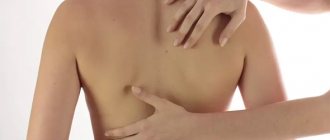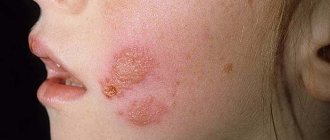What is herpes zoster?
Herpes zoster, also called shingles, is an infectious disease caused by the chickenpox virus. This is the same virus that causes chickenpox. Herpes zoster occurs only in those people who have previously had chickenpox. When chickenpox goes away, the varicella zoster virus remains in the body as inactive. This means you may not feel symptoms, but the virus is still present in your body. When the varicella zoster virus becomes active again, it causes herpes zoster.
to come back to the beginning
Symptoms
The symptoms of shingles in the initial stages are very similar to chickenpox. The incubation period is from 2 to 4 weeks. Clinical manifestations include:
- the appearance of red spots on the skin that slowly spread throughout the body;
- redness is localized along the nerve trunks of mainly one half of the body: the area of the ribs, shoulder blades, lower back, less often on the face;
- The appearance of pain at the site of the lesion is characteristic: the pain is burning, intensifies at night.
Blisters similar to chickenpox are visualized 3-4 days after the onset of the disease. At the same time, the lymph nodes may enlarge and the temperature may rise, which lasts for several days. The contents of the vesicles become cloudy, and then they begin to dry out, forming yellow crusts. The whole process takes 6-8 days. The crusts disappear after 3 weeks. After the active stage, pain persists until complete recovery.
How is herpes zoster spread?
Herpes zoster can be spread by touching the blisters of an infected person. Disseminated herpes zoster can spread through contact with droplets from the nose and throat of an infected person. Droplets containing the virus become airborne when an infected person coughs or sneezes. They are easy to inhale and become infected.
If you have had chickenpox before, your virus will not become active as a result of contact with someone who has herpes zoster. However, if you have not had chickenpox, you may get it after being exposed to someone who has herpes zoster.
to come back to the beginning
Herpes zoster: age characteristics and treatment options
I.G. Sergeeva, Yu.M Krinitsyna, E.A. Feoktistova, O. O. Emelyanova
Novosibirsk State University, municipal dermatovenerological dispensaries 4 and 6, Novosibirsk
Shingles is caused by the herpes virus type 1P. Primary infection with it usually occurs in childhood and manifests itself clinically in the form of chickenpox, after which the virus continues to persist for a long time in the peripheral nerve plexuses, spinal ganglia and ganglia of the cranial nerves. Reactivation of the virus and, as a consequence, the occurrence of herpes zoster is facilitated by immunodeficiency states of various origins, including HIV infection, visceral pathology, old age, hypothermia, trauma and other risk factors [1-5].
At an outpatient appointment among 6927 patients from 6 months to 92 years, 124 (1.8%) visits were for herpes zoster. The patients were aged from 20 to 81 years (mean age 51.0 1 15.3 years), 43 (34.7%) men, 81 (65.3%) women. To assess the characteristics of the course of the disease in old age, all patients were divided into two groups: 77 people aged from 20 to 59 years and 47 patients aged from 60 to 81 years. The male to female treatment ratio of 1:1.9 was maintained in both age groups.
In all cases, several days before the appearance of skin rashes, patients were bothered by a burning sensation and pain in the places where the rashes subsequently appeared. Painful sensations were taken as an exacerbation of pathologies of internal organs (cholestitis, PISLONSFRIT) or the spine (osteochondrosis), for which patients began treatment on their own, and the appearance of rashes was regarded as an allergic reaction to the drugs they were taking.
Among the provoking factors, patients most often named hypothermia; in 2 cases, it was possible to establish contact with patients with chickenpox; in 1 case, the patient considered injury to be the cause of the rash.
The timing of contacting a dermatologist for herpes zoster is crucial for adequate therapy. In the first three days of the disease, 24.2% of patients under 59 years of age and 20.0% of elderly patients turned up. On days 4-5 - 37.1% and 30%, respectively. On DAYS 6-7 - 25.8% and 22.5%, respectively. When the disease lasted more than 7 days - 12.9% and 27.5%, respectively. Thus, older patients consulted a dermatologist later, and the time before starting antiviral therapy increased accordingly.
The localization of the rashes was represented by the following arrangement of elements. On the skin of the head and neck (in the areas of innervation of the facial and tertiary nerves), manifestations of herpes zoster were observed in 8 (10.4%) patients under the age of 59 years and in 5 (10.6%) patients over 60 years of age. On the skin of the trunk along the intercostal nerves - in 57 (74%) and 24 (51.1%), respectively. On the skin of the upper spine (along the brachial and radial nerves) - in 5 (6.5%) and 12 (25.5%), respectively. On the skin of the buttocks and lower extremities (along the sciatic nerve) - in 7 (9.1%) and 6 (12.8%), respectively.
Clinical manifestations of the disease were typical for herpes zoster. Along the course of the nerves there were grouped vesicles on hyperemic and somewhat swollen skin. When patients presented late, erosions and crusts developed at the site of the vesicles. Among patients under 59 years old, the presence of grouped vesicular elements was in 62 (80.5%), erosions at the site of vesicles - in 6 (7.8%), crusts - in 9 (11.6%), mainly in patients who applied later than 7 days from the onset of the disease. Among patients over 60 years of age, vesicles were observed in 29 (61.7%), erosions in 2 (4.3%), and crusts in 16 (34%). Elderly patients had 2 cases of complications with pyoderma, and 2 patients had a hemorrhagic form of herpes zoster. When the clinical manifestations resolved, hyperpigmented spots remained on the skin; in the first elderly patient, a boil developed in the area of the rash. After resolution of the skin rashes, neuralgia remained in 10 (12.9%) patients under 59 years of age and in 15 (31.9%) patients over 60 years of age, requiring medical correction.
Considering the peculiarities of the occurrence of herpes zoster, much attention was paid to the combination of the disease with the pathology of internal organs. The presence of somatic pathology was taken into account according to records in outpatient therapeutic cards. Among patients under 59 years of age, the presence of concomitant somatic pathology was noted in 15 (19.5%), in patients over 60 years of age - in 21 (44.7%).
From treatment experience
Patients under 59 years of age most often had a history of cancer - in 4 (5.2%), these were women with tumor diseases of the uterus, testes and mammary glands. Diseases of the gastrointestinal tract: cholecystitis - in 4 (5.2%), gastritis - in 2 (2.6%). Pathology of the endocrine system: thyroid gland - in 3 (3.9%), diabetes mellitus - in 2 (2.6%). Diseases of the musculoskeletal system - in 3 people. In isolated cases, we encountered pathology of the excretory system (a combination of urolithiasis with pyelonephritis and cystitis), chronic bronchitis, tonsillitis, otitis media, hepatitis, vegetative-vascular dystonia, pancreatitis.
In patients over 60 years of age, pathology of the endocrine system was most often noted: diabetes mellitus - in 4 (8.5%), hypothyroidism - in 3 (6.4%). Oncological diseases for which a history of resections were made or patients received chemotherapy (bladder, intestinal, breast, stomach, blood diseases) - in 6 (12.8%), in one patient unmotivated weight loss of 20 kilograms for which she was not examined. Pathology of the musculoskeletal system was detected in 4 (8.5%). Diseases of the cardiovascular system were represented by coronary heart disease - in 3 patients, hypertension - in 2, arrhythmia and rheumatic carditis in isolated cases. Pathology of the gastrointestinal tract - cholelithiasis - in 3 people, chronic pyelonephritis - in 2, parasitosis (giardiasis) - in one patient.
Changes in the general blood test in patients with herpes zoster were nonspecific and mild. Average general blood test values in patients 20 - 59 years old: red blood cells 4.4 ± 0.2 x 10'2/l; hemoglobin 139.0 ± 8.4 g/l; leukocytes 5.3 ± 1.4 x 10°/l; eosinophils - 2.6 ± 1.7%; band neutrophils - 2.0 ± 1.7%; segmented neutrophils - 53.5 ± 6.4%; lymphocytes - 35.2 ± 7.1%; monocytes - 4.9 ± 3.2%. The erythrocyte sedimentation rate was 8.8 ± 3.5 mm/hour.
In patients over 60 years of age, the number of erythrocytes and hemoglobin was within normal limits (4.5 ± 0.1 x 10'2/l and 141.0 ± 10.8 g/l, respectively). Leukocyte formula: leukocytes 5.9 ± 1.4 x 10°/l, eosinophils 1.6 ± 1.1%, band neutrophils 1.8 ± 0.6%; segmented neutrophils 55.2 ± 8.3%; lymphocytes 34.1 ± 5.8%; monocytes 4.6 ± 1.0%, ESR - 9.6 ± 3.8 mm/hour.
One group of patients (44 patients) who applied within 7 days of the onset of the rash received antiviral therapy with acyclovir 200 mg 5 times a day for 8 days, the other group (25 patients) received a 0.004% solution of Panavir (5 ml) intravenously in a bolus every 48 hours, 3 infusions per course.
The eruption of new blisters when using acyclovir stopped after 2 - 4 days. In patients receiving acyclovir, crusts and slight erythema remained on the skin by the end of 8 days of therapy. In 13 people, postherpetic neuralgia remained after the end of therapy. One patient developed toxicoderma on the 2nd day of taking acyclovir.
After one infusion of Panavir, a significant decrease in the brightness of the erythema was noted, the formation of crusts began and the spread of the process stopped. All patients noted a significant reduction in pain within 48 hours after the start of treatment. By the end of the course of therapy, slight erythema and epithelialized erosions at the site of the vesicles remained on the skin; crusts at the end of treatment were observed only in 3 people. After treatment with Panavir, postherpetic neuralgia did not develop; in 2 patients, paresthesia in the area of the rash persisted, but they did not require further treatment. All patients tolerated the drug well, and no adverse reactions to Panavir were noted. With the same duration of therapy, the use of Panavir allows you to reduce the frequency of administration of the drug (40 tablets of acyclovir or 3 intravenous infusions of Panavir), reduce the time for the appearance of new vesicles and epithelization of erosions, and reduce the severity of postherpetic neuralgia.
Assessing the age-related characteristics of the course of herpes zoster, we noted that older patients more often have lesions localized on the skin of the upper extremities, and later turn to a dermatologist; in many cases, already after the progression of the disease has stopped, postherpetic neuralgia is more typical for this age. It is at this age that complicated and atypical variants of herpes zoster occur. In old age, shingles is 2 or more times more likely than in people under 59 years of age to be combined with cancer and pathology of the endocrine system. Thus, it is in this age group that it is relevant to prescribe highly effective courses of therapy with the drug Panavir, which allows, with a MINIMAL drug load and a low risk of side effects, to achieve good therapeutic indicators.
LITERATURE:
1. Shelyuzhenko A.A., Brailovsky A.Ya. Skin diseases in elderly and senile people. Kyiv. Health, 1982. - p. 200.
2. Krivosheev B.N., Krinitsyna Yu.M., Efremova E.E. et al. Famtslovir and acyclovir in the treatment of herpes zoster. Act question modern med.: Abstracts of reports. 10 scientific-practical conference. doctors. Novosibirsk 2000. - p. 377.
3. Gilden DH, Dueland AN, Devlin ME et al. Varicella-zoster virus reactivation without rash. J Infect Dis.1992; 166(suppl I): 30–4.
4. Beacham BE Common dermatoses in the elderly. Am Fam Physician. 1993; 47(6): 1445–50.
5. Higa K., Mori M., Hirata K. et al. Severity of skin lesions of herpes zoster at the worst phase rather than age and involved region most influences the duration of acute herpetic pain. Pain. 1997; 69(3): 245–53.
Reviews about Panavir, questions, doctor's comments
What precautions does the hospital take if I have herpes zoster?
Isolation measures are the measures we take to prevent the spread of infection among patients. If you were diagnosed with chickenpox during your hospital stay or were exposed to chickenpox:
- You will be placed in a separate room.
- The door to your room should always be closed.
- A sign will be posted on your door asking all staff and visitors to wash their hands with soap and water or use an alcohol-based hand rub before entering and after leaving your room.
- Isolation measures taken in the case of localized and disseminated herpes zoster are different. For localized herpes zoster, all visitors and staff should wear a yellow gown and gloves while in your room. They are distributed outside your room and can be disposed of in your room.
- For disseminated herpes zoster, visitors and staff should wear a yellow gown, gloves, and a face mask while in your room. While following these isolation measures, you are prohibited from walking around the unit.
- a food pantry in your department;
You can stop taking these precautions once all the blisters have dried out and crusted over.
to come back to the beginning
Varieties
There are 5 types of herpes zoster in total.
- abortive. The mildest form, which is characterized by a rapid course of the disease. The erythematous-papular rash lasts several days, there are no vesicles.
- generalized. It is characterized by local specific manifestation and distribution of vesicles throughout the body, including mucous membranes. The duration of illness is 2-3 weeks. If symptoms persist beyond this period, then the development of immunodeficiency or a history of malignant neoplasms is possible.
- bullous Characteristic clinical manifestations are large vesicles with serous fluid. Tend to merge.
- gangrenous. Causes necrotic skin changes. This form is typical for patients with immunodeficiency and is a marker of AIDS.
- hemorrhagic. Vesicles with blood content are characteristic. After recovery, deep scars remain.
Make an appointment
Disease prognosis
With proper and timely treatment of herpes zoster in adults, the prognosis is usually favorable. In autumn and spring, an exacerbation of the disease may occur.
The following consequences of shingles may develop:
- in severe form – development of facial nerve paralysis;
- if the eyes are affected, there is a high probability of developing optic neuritis;
- meningoencephalitis – a consequence of the encephalitic form of herpes zoster;
- severe disorders of internal organs.
If you need advice from an experienced specialist, contact the clinic. Our doctors will talk about many of the nuances of the described disease - in particular, how to treat herpes zoster in older people. You can sign up for a consultation on the website and by calling the numbers provided.
Related services: Consultation with a dermatologist Dermatovenereology
Forms of the disease, its onset
The following forms of the disease are distinguished:
- ophthalmic;
- ear;
- gangliocutaneous;
- necrotic;
- abortifacient;
- hemorrhagic;
- meningoencephalitic;
- bullous
The disease begins with general malaise and neurological pain. In addition, the patient complains of gastrointestinal disorders (dyspeptic disorders), headache, chills, pain and burning in those parts of the body where rashes will subsequently appear. The onset of the disease is characterized by low-grade fever and pain in the lymph nodes. The duration of the initial stage is from 24 hours to 4 days. To the question of whether shingles is contagious, the answer is yes.







